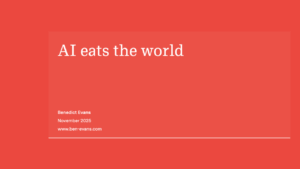
As a digital analyst, I spend a lot of his time thinking about the future of customer experience. So much so that my next book attempts to rethink the term “experience,” X:The Experience of Business Meets Design. “X” explores experience architecture the various ways companies can design meaningful and shareable experiences in every moment of truth.
I recently spent time with the team at VisionCritical as part of the prep for its their upcoming conference in Chicago, 2015 Vision Critical Summit. My presentation is based on X and the conversation about what it should cover resulted into something that they felt worth sharing and I did too.
I hope it helps you. Please share your experiences in the comments…
Your book tackles the idea of experiential marketing. How is experiential marketing different from traditional marketing, and why should companies care about it?
X is about experiences and experiential architecture, and marketing is just one part of it. Customer experience is beyond just any one moment. It’s every moment plus all moments combined. You have a few great moments and some not-so-great moments. The problem with the approach to marketing today is each one of those moments is owned, managed and measured by different groups, and those groups don’t always collaborate. Nor are they working on a common vision of what those moments should be. They’re almost working to fail when you look at the experience collectively.
Looking at marketing as a slice of the experiential pie, traditional marketing is very ego-centric. Someone’s idea is executed by a team and then measured by how that idea performs. Ideas are ego-driven and are driven by campaigns, so they come and go. In contrast, an experience is something that doesn’t stop. Customer experience happens with or without direct interaction with marketing. If I use a product, look at your website or come across your campaign, these things happen without the company knowing my impressions, my expressions or what I say about them to others.
Experiential marketing is about starting with a vision, executing to get that vision, and then collaborating with the rest of the organization to ensure that it is met and delivered consistently. In a sense, experiential marketing pushes marketing to become bigger than its role today. It ensures that experience is kept on point and kept alive throughout the lifecycle.
In an interview with PSFK, you mentioned that brands often lack a holistic, 360-degree view of the customer. What are the challenges facing brands in terms of truly getting a more complete picture of their customers?
Some departments are now accelerating their efforts in customer research, data-driven marketing, customer service and loyalty (through their CRM system). The problem is that these efforts often lack integration with existing data. Many people in the organization have no way of getting data that’s already available.
Integrating customer data is important because it allows companies to take action. It’s what you do with data that really matters. It’s how you are inspired by data to improve your business.
Companies have net promoter scores to look at whether or not the customer is happy. We have surveys. We have customer support initiatives that will ask something like “did we answer all your questions today?” We have customer sentiment in terms of marketing response, impressions, clicks, views, etc. But all of these give us an incredibly limited view of the customer. We don’t really get an idea of who the customer is.
Some companies (especially those in marketing and customer experience design) are getting into persona development. They’re starting to humanize their customers. But there is no chief customer architect who’s asking, “What’s really important to our customers?” No one in the company is asking, “How do we bring all the insights we have and ensure that we’re delivering the things that will improve every customer touch point?”
From a product design and human-centered approach perspective, IDEO is a great example to follow. The company is rethinking how it conducts business with a single view of the customer and delivers against that standard. And IDEO shows that the key is not just about setting up data columns and creating personas. It’s about building an infrastructure to ensure that the customer journey is consistent. A true 360-degree view of customer is not just about omnichannel, data or CRM. It’s about people working together with a purpose.
You’ve spent a lot of time thinking about the future of customer experience. What are some of the traits of companies that get CX?
They are inspired by their customers. Everything they do is by and for their customers.
A common idea is that a great experience is something that happens only from a customer service perspective. A misconception is that customer experience is about having a wonderful shopping experience or having great sales professionals who help you find what you’re looking for.
That’s not an experience. In reality, experience is the sum of all touches throughout the customer relationship. The companies that understand this look at that philosophy and apply it across the board. They’re re-examining everything from their brand messaging to their products to their packaging and product design. They are trying to figure out, “How can we be more useful? What keeps our customers frustrated? And what are their aspirations?” These are foundations based on social science, being more human-centered with the aim of being more relevant and engaging. They reinvent the entire infrastructure of their organization to matter.
One of the best traits of organizations that are changing is that they take a step back and evaluate the customer experience, identify the frictions and imagine what could be. That last part, that’s the area for innovation right there. It’s not just about optimizing within; it’s also about looking at the future—at what could be.
You recently did a study with CapGemini Consulting about innovation centers and how big brands are using them. One of the key findings is that some industries (e.g. Telecom) have been laggards adopting innovation centers. What factors hold these industries back, and what can they do to catch up?
Innovation is based on a vision of what’s possible and the pursuit of what’s possible. Doing that takes leadership.
A lot of times, organizations are designed and managed from a “management” perspective. They develop processes, put them into place, and use that as a metric of success. A leadership organization is about what could you do better and what could you do differently. It’s informed not by bureaucratic processes or navel gazing, but driven by insights.
Remember that disruption comes from anywhere. Everyone looks at the number one or number two organization in their sector, but disruption is not just about your competitors. When you are too focused on your competitors, you ultimately get caught up in the game of irrelevance. When you only look at your competitors, what you see is the emergence of companies like Uber and Airbnb—disruptive startups that are human-centered for a different kind of a customer.
It’s not just about millennials and Gen Z either. It’s about how technology and lifestyle evolution are changing the behaviors and expectations of people. Innovative organizations recognize it’s just a matter of time before a well-funded startup competes against them. Startups have the advantage because they don’t have legacy and politics and other typical corporate challenges that stand in the way of seeing new possibilities.
Most companies have R&D facilities. But even those companies don’t facilitate innovation. Innovation comes from being inspired by your customers. It comes back to this mantra: Disrupt to be disrupted. It’s inevitable.
Technology is a sector that is inherently innovative, but it doesn’t really matter what industry you’re in and what type of business you’re in, whether it’s B2B or B2C or even government, medical or what have you. It really has more to do with the culture of the organization. That may sound abstract, but culture really is the most important thing in the organization. It’s also one of the most underrated competitive advantages any company could have. In leadership organizations, culture is the trait of innovation. There’s a feeling of empowerment and aspiration and challenge. Those traits are not industry specific; they’re human specific, and regardless of your industry or role, sometimes the best way to shift the company comes from the middle. Visionaries like Richard Branson and Howard Schultz are rare. Change happen because people in the organization believe that there’s a better way of doing things and bring disruption from the inside out.
You recently blogged about the six stages of digital transformation maturity. What role does customer engagement and listening have in this process?
Digital transformation is something that is enterprise-wide. In fact, it’s beyond the enterprise. It’s about the entire ecosystem of an organization, from supply chain, to retail, to sales channels. It’s about leveraging technology to improve or invent new models or processes for businesses in a digital time.
I focused my research on customer experience because digital transformation needs a catalyst. There’s no budget for “digital transformation.” It’s also not driven by the information technology organization. When we think about digital transformation, we really have to think about technology. How is your company leveraging new technology to drive innovation?
Digital technology is driven by the desire and need to uncover who your customers are and how they behave. Customer experience is often a catalyst because it represents a dollar sign in the organization.
The people thinking about digital transformation are thinking about ways of optimizing the customer journey. Even companies like Google are thinking about this topic. While Google makes its money through Search, it recently introduced what it calls “micro-moments” to help businesses understand that the customer is changing. The information customers are looking for and the devices they use are evolving, but most companies are still operating in a Web 1.0 world. One of the biggest opportunities is to rethink everything—just to step back and think, “hey, what’s the point of our website in the mobile world today, and how could we reinvent it to make it more useful and more meaningful to today’s customers?”
In the business world, you’re going to hear more about social sciences because when we’re talking about customer engagement, what we’re really talking about is anthropology and ethnography—looking at ways to understand the customer and identify archetypes for your ideal customer. Social sciences will help inspire companies to achieve different states of being, if you will.
When you engage with your customers, you can get insight, but what you do with that information is what drives change in the enterprise. It’s not about profit, it’s not about process improvement, technology to scale, or efficiencies. What we’re really looking at is customer-driven insight to find ways to disrupt yourself, not just in how you work but also in what’s possible. The idea of disruption because of customer insight and customer experience is looking at not just how you would improve customer experience, but how would you disrupt it? It’s about thinking and acting almost like a startup.
When it comes to customer engagement, the questions you ask inform the answers you get. Social science is going to be one of the biggest champions for driving evolution and revolution in business. It’s dependent on the person asking the question. IP information If you have the same old questions, then you’ll get the same old answers. If you’re using the same processes and models, then we’re not going to move towards a new direction.
Connect with me… Twitter | LinkedIn | Facebook | Youtube | Instagram | Pinterest





At the end of the day it all really comes down to customer experience. Everything we do as a business to increase our marketing efforts boils down to the potential customer to create an action that helps improve the standing of the business. Whether that is a monetary goal or an engagement goal without a good customer experience nothing will work well.
Thank you for sharing.